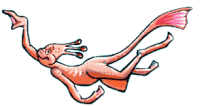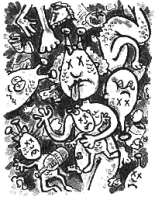- Come on in, the water's fine:
-
 To help keep your Sea-Monkeys water at a cozy 70+ degrees, pick up
an aquarium thermometer from your local pet store. These inexpensive
units are a thin, smallish piece of plastic that will stick right on
the OUTSIDE of your Ocean-Zoo tank and help you chart the comfort-zone
within.
To help keep your Sea-Monkeys water at a cozy 70+ degrees, pick up
an aquarium thermometer from your local pet store. These inexpensive
units are a thin, smallish piece of plastic that will stick right on
the OUTSIDE of your Ocean-Zoo tank and help you chart the comfort-zone
within.
- Feeding frenzy:
- There seems to be some confusion over feeding Sea-Monkeys. This is
due to conflicting directions in the variety of Sea-Monkey handbooks
and instruction sheets currently on the market. The Growth Food packet
and illustrated instruction sheet states every 8 to 10 days, the new
Magic Castle and old handbook says once a week, and the new handbook
is amended to read every 3 days. So what's a Sea-Monkey parent to do?
This just in: Here's the latest word on feeding Sea-Monkeys
according to ExploraToy. First feeding: Feed 5 days after hatching
with the small end of the Aqua-Measure Spoon. Regular feedings:
Continue feeding once a week with the small end of the Aqua-Measure
Spoon. Adult Sea-Monkeys: As your Sea-Monkeys grow larger,
use the large end of the Aqua-Measure Spoon and feed once a week.Cloudy
water: If the water gets cloudy, you're over-feeding and should
stop adding food until the water clears. Common sense: Employ
common sense. Obviously, you would feed 5 dogs MORE food than you
would feed just 1. This is the same with Sea-Monkeys. My suggestion
is to begin with weekly feedings and adjust the amount and frequency
based on the number of Sea-Monkeys you have, their size, and your
daily observations.
- What's it all about, algae:
- Exposure to INDIRECT sunlight is one of the BEST GIFTS you can give
your Sea-Monkey pets. Natural sunlight allows algae (an underwater vegetation)
to grow in the tank. This serves your briny breed in two ways: 1.) It
provides them with a SCRUMPTIOUS food source they will enjoy "grazing"
on, and 2.) the algae puts off oxygen providing them with an ample supply
of air to breath in their watery underworld. Caution: Direct
sunlight will be TOO HOT for your aqua-pets so make sure you don't accidentally
cook up a batch of boiled shrimp by leaving them in DIRECT sunlight.
Note: If an indirect natural sun source is not available, a grow
lamp (used for plants) will also get the job done. Once again, be sure
to monitor the waters temperature to keep your Sea-Monkeys comfortable
and happy.
- Breath of life:
- Sea-Monkeys need oxygen in their water in order to survive. This can
be accomplished several ways;
- 1.) Stir the Sea-Monkey water with a plastic spoon handle,
straw, or swizzle stick. This will help a little bit but it is the least
desirable way of adding oxygen to your tank. Make sure the stirring
device is sterile -- see "Soap duds" below.
- 2.) Pour the Sea-Monkey water back and forth (several times)
from their tank into another sterile container. They will enjoy the
ride and it will give them a breath of fresh air.
- 3.) The PREFERRED method is to aerate the water with a "Million-Bubble
Air Pump". If one did not come with your Sea-Monkeys kit, they can be
ordered from the back of your "Official Sea-Monkey Handbook".
- 4.) If you happen to have a low power electric aquarium pump
around the house, you can use this to keep a constant flow of air streaming
into your Ocean-Zoo. You'll also need a filter and some clear plastic
tubing to run from the air pump to the filter in your Sea-Monkey tank.
All of these items can be purchased from your local pet store. Caution:
A high power air pump may cause too much motion in the water. Make sure
your Sea-Monkey pets are able to swim freely and are not being violently
tossed around by an extreme air flow.
- Soap duds:
- When using ANY item that will come in contact with your Sea-Monkey's
water, make sure it is washed thoroughly but do NOT use any soaps or
detergents in the process. Cleansers contain chemicals that can kill
your sea creatures. This next tip requires ADULT SUPERVISION: To insure
an item is sterile, boil it in water. This will kill any bacteria or
agents that may be harmful to your Sea-Monkey pets. Remember, ASK FOR
ASSISTANCE!
|
- The Carbonic Plague:
-
 The first seven days of a Sea-Monkey's life are critical. I highly
recommend aerating the tank EVERY DAY for the FIRST WEEK. One of the
greatest enemies for Sea-Monkeys is carbon dioxide. Carbon dioxide is
a gas which all animals naturally produce but is more important to underwater
animals than to land animals. In water, some of the carbon dioxide forms
a compound called carbonic acid. This is a very weak acid but it is
strong enough to kill Brine Shrimp. If there is too much carbonic acid
present in your tank, Sea-Monkeys cannot make use of the oxygen that
is available to them. As a result, they suffocate. So for the best results
(and as a precautionary measure), aerate on a daily basis the first
week. And if your Sea-Monkeys begin swimming in a sluggish manner, START
AERATING again immediately to supply them with oxygen and help fight
off the toxic carbonic acid.
The first seven days of a Sea-Monkey's life are critical. I highly
recommend aerating the tank EVERY DAY for the FIRST WEEK. One of the
greatest enemies for Sea-Monkeys is carbon dioxide. Carbon dioxide is
a gas which all animals naturally produce but is more important to underwater
animals than to land animals. In water, some of the carbon dioxide forms
a compound called carbonic acid. This is a very weak acid but it is
strong enough to kill Brine Shrimp. If there is too much carbonic acid
present in your tank, Sea-Monkeys cannot make use of the oxygen that
is available to them. As a result, they suffocate. So for the best results
(and as a precautionary measure), aerate on a daily basis the first
week. And if your Sea-Monkeys begin swimming in a sluggish manner, START
AERATING again immediately to supply them with oxygen and help fight
off the toxic carbonic acid.
- To clean, or not to clean?:
- As your Sea-Monkeys age, sediment will begin to gather in the bottom
of your tank -- a combination of food, algae, waste and un-hatched eggs.
This is a natural part of the process and is not necessarily harmful
to your pets. In fact, the Sea-Monkeys seem to enjoy routing around
the murky basin. I choose not to clean my tanks -- rather let the process
in their ecosystem continue naturally.
If you are neat by nature and demand a tidy bowl, a Sea-Monkey Aqua-Leash
makes a great aquatic vacuum cleaner. It has also been reported that
pouring the water through a household coffee filter is an effective
way of removing the debris. Keep in mind this will also filter out
any dormant eggs that reside in the murk and muck.
When an adult Sea-Monkey passes on, their blackened carcass will
sink to the bottom of the Ocean-Zoo floor. These deceased Sea-Monkeys
should be removed. An Aqua-Leash is a handy utensil for this task
as well. In a pinch, a new straw or sterile eye dropper might also
serve the purpose.
- A salty crew:
- As the name suggests, Brine Shrimp live in "brine", the name given
to VERY salty water. This crustacean lives well in many places but perhaps
best in two very salty lakes -- the Great Salt Lake in Utah and the
Salton Sea in California. These lakes are all that is left of two very
large salty seas which are steadily evaporating and becoming more salty.
Only a few animals and plants can live in the extreme salty water of
these lakes. One breed that thrives in these conditions is the Brine
Shrimp. Once your Sea-Monkey tank is fully assembled and ingredients
#1 and #2 have been added, the water has been specially formulated with
the exact salt content needed for your briny pets to thrive. As water
evaporates from your tank, the salt consistency will strengthen. To
learn how to combat this, see "Water Evaporation" below.
- Water evaporation:
- As the water slowly evaporates in your Sea-Monkey tank, the salt content
remains behind and the water becomes more salt concentrated. Sea-Monkeys
adapt well to the gradual process of their water world becoming more
salty as the water level drops. However, replenishing the water can
be a shock to their system as the salt concentration quickly changes
when fresh water is added back to their tank. The more water that has
evaporated from the tank, the greater the shock to their system when
the water is replaced. For this reason, it is recommended to replenish
the evaporated water when the level has dropped by one or two inches
in your tank. When replenishing water, it is recommended you use room
temperature distilled water or boiled tap water that has been left to
cool for 24 hours or until it has reached room temperature.
- Pump up the volume:
- Here's a tip on how to make a "Million-Bubble Air Pump" a permanent
part of your Ocean-Zoo aquarium. This requires ADULT SUPERVISION. You'll
need HELP from a PARENT or GUARDIAN who has access to a hand drill and
a 1/2" drill bit. Take the Aeration lid from your Ocean-Zoo tank and
have an adult guardian drill a 1/2" hole through the top of the lid.
This newly drilled hole gives your "Million-Bubble Air Pump" an opening
where it can dangle in your tank and still allow you to keep your Sea-Monkey
tank covered at all times. This makes it really EASY to give your pets
a "squirt" of air any time you pass their tank. And we all know, when
it comes to Sea-Monkeys, oxygen is a GOOD THING!
|
